
Starting a campfire can be quick and easy if you know the proper steps. Whether camping in the woods, in your backyard, or at a campground, having a campfire is a long-standing tradition. A campfire is a great place to prepare meals. In addition, it provides warmth, light, and a cozy gathering place.
Building a campfire can be quick and easy by following these simple steps. 1. Gather the materials: tinder, kindling, and firewood. 2. Take the time to construct a proper structure. 3. Light the tinder. 4. As the fire grows, add additional wood to sustain it.
Read on for more information about quickly starting a campfire using the appropriate materials and techniques.
1. Gathering the Materials
Select only dry materials when building a campfire, as wet or damp wood will not burn as easily or as hot. To determine if the wood is dry, try breaking a few sticks and see how easily it splinters. If the wood snaps easily, it’s likely dry and ready to use. Additionally, wood stored in a dry place for a few months is ideal.
Also, the type of wood used will significantly affect your fire. The best choice for a longer-lasting fire is hardwoods like oak, maple, and hickory, as they burn longer. Softwoods such as hemlock or pine make excellent kindling to help start the fire, but avoid them as the main firewood because they create a fire that will burn fast, produce sparks, and quickly burn out. Additionally, avoid using any wood that’s painted, stained, or treated, as these can contain chemicals that can be harmful when burned.
To quickly get a campfire going, you need a combination of three components: tinder, kindling, and firewood. Tinder is the smallest and most combustible material. Kindling is slightly larger pieces of wood, which will help sustain the fire as it grows. Finally, firewood is the larger pieces of wood that will form the core of the fire. Once you successfully combine the three fuel sources, you should have a roaring fire..
- Tinder is any highly combustible material that burns quickly and easily. The primary purpose of tinder is to ignite the kindling. Good examples of natural tinder include dried grass, pine needles, bark, cattail fluff, and small twigs. Other useable items include newspaper, cardboard, paracord, cotton balls coated with petroleum jelly and commercial products.
- Kindling is larger than tinder, about 1 inch around or less; look for dried twigs, sticks, pinecones, and pieces split off larger logs. Once the kindling begins burning, it will ignite the larger pieces of firewood.
- Firewood is larger pieces that sustain the fire; 3-4 inches in diameter work best to maintain a fire. If you want a longer-lasting fire, use larger logs, as they burn slower than smaller logs.
Van Camping Life Tip: Having an extra supply of kindling and firewood nearby is a good idea when starting a fire.
A few basic camp tools are helpful when preparing campfire materials, including a hatchet for splitting logs and shaving off bits of tinder, a sharp knife to make feather sticks, and a folding saw to cut long pieces of wood too big to break by hand
2. Building the Campfire
There are numerous ways to build a campfire. Regardless of your preferred method, the key to having a campfire that you can quickly start is to make sure you do the preparation work ahead of time. That means getting the proper-sized tinder, kindling, and firewood. Arrange in the correct order before igniting the fire; when done correctly, the campfire should light easily.
Teepee
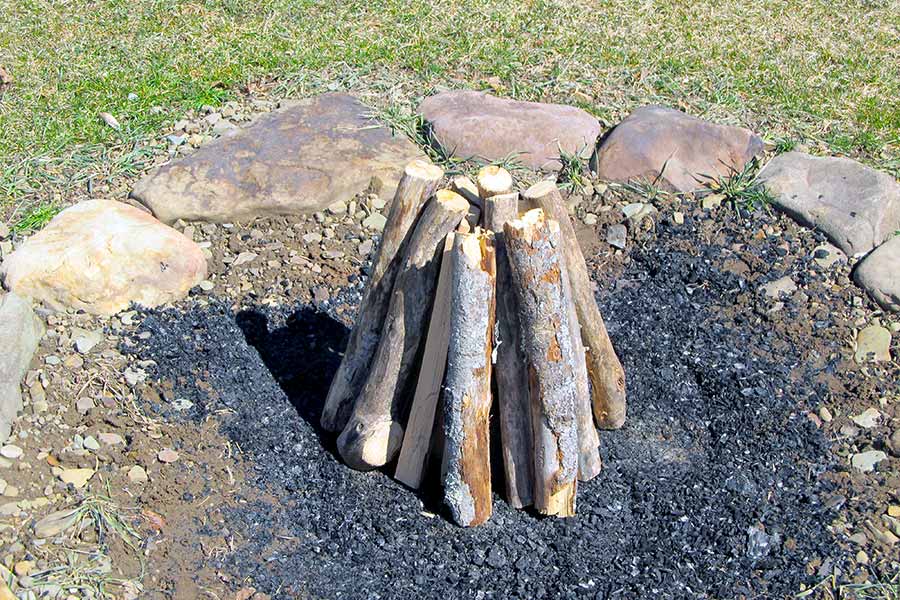
This is a popular method of building a fire. It’s a great option because it’s easy to assemble and provides quick heat.
- Place a large pile of tinder on the ground in the center of the fire pit.
- Position small twigs around the tinder in a teepee shape, leaving space between pieces to create airflow. Add additional layers of increasingly larger pieces as you build the teepee.
- Ignite the tinder. Once the fire is established, add larger pieces, a few at a time to feed the fire.
Log Cabin
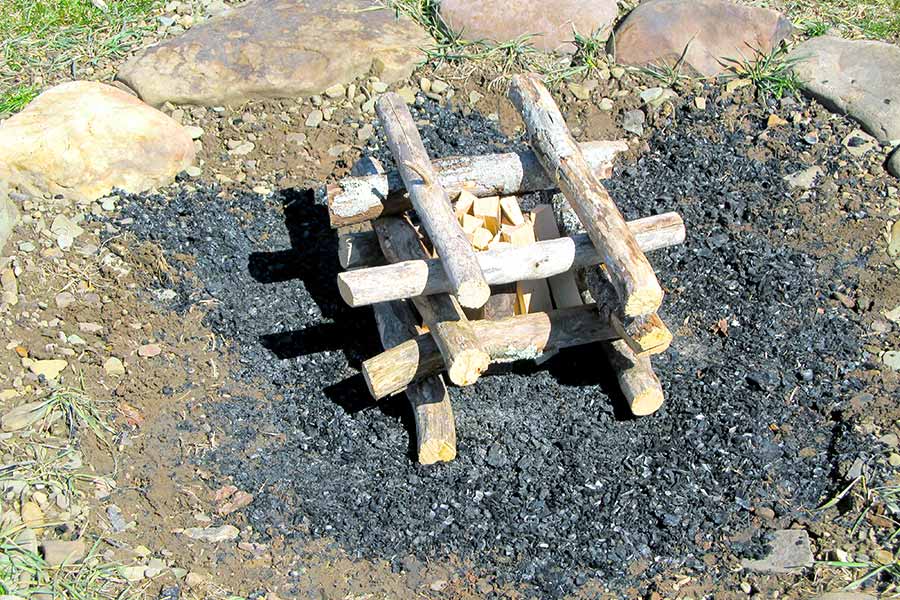
This method involves stacking wood in an alternating pattern to create a structure of multiple layers where tinder and kindling are placed in the center.
- Position two pieces of firewood parallel to each other about 12 inches apart in the fire pit, then add two more on top of those at a right angle to the first two.
- Place a pile of tinder and small twigs inside the square, or alternatively build a small teepee.
- Repeat the stacking process to the desired height—generally, 4 to 5 layers to form a box-shaped cabin.
- Ignite the tinder. Add additional wood as needed.
Lean-To
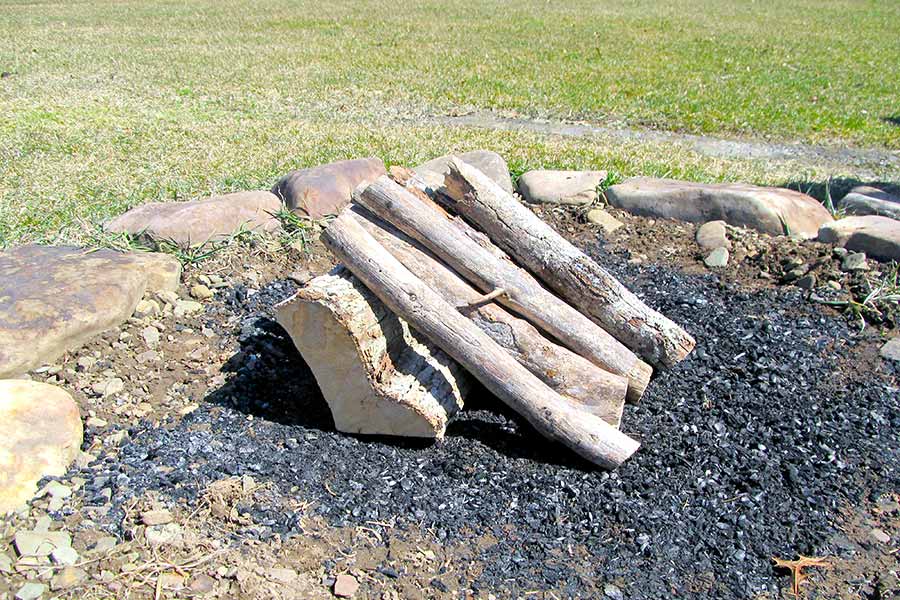
This structure gets its name from leaning small twigs and sticks over a large base log. This method creates a system that utilizes the log for fuel while allowing good airflow to feed the fire.
- Select a large log and place it in the fire pit. Now place a pile of tinder beside it.
- Lean small twigs and sticks against the log at an angle overtop the tinder, forming a lean-to structure, leaving space between the pieces for airflow.
- Ignite the tinder. Add larger sticks to the structure as the fire grows, leaning them against the base log.
Pyramid
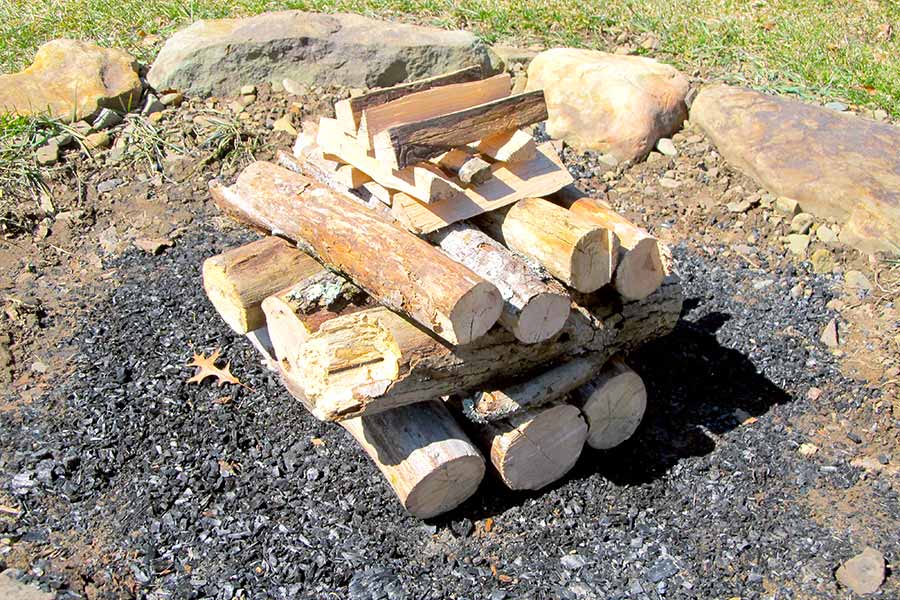
This method creates a fire that burns from the top down. Build this structure when you want a long-lasting fire, want to cook over the fire, or want to minimize frequently tending the fire.
- In the fire pit, position several large logs side-by-side and tight together, then place a layer of smaller logs perpendicular to the bottom logs, creating a square or rectangle shape.
- Repeat adding a layer of smaller pieces perpendicular to each other, followed by another layer of smaller-sized pieces, until you have a pyramid shape.
- Add a pile of tinder and small twigs on the top.
- Ignite the tinder. The fire burns from the top down, creating a long-lasting fire.
Star
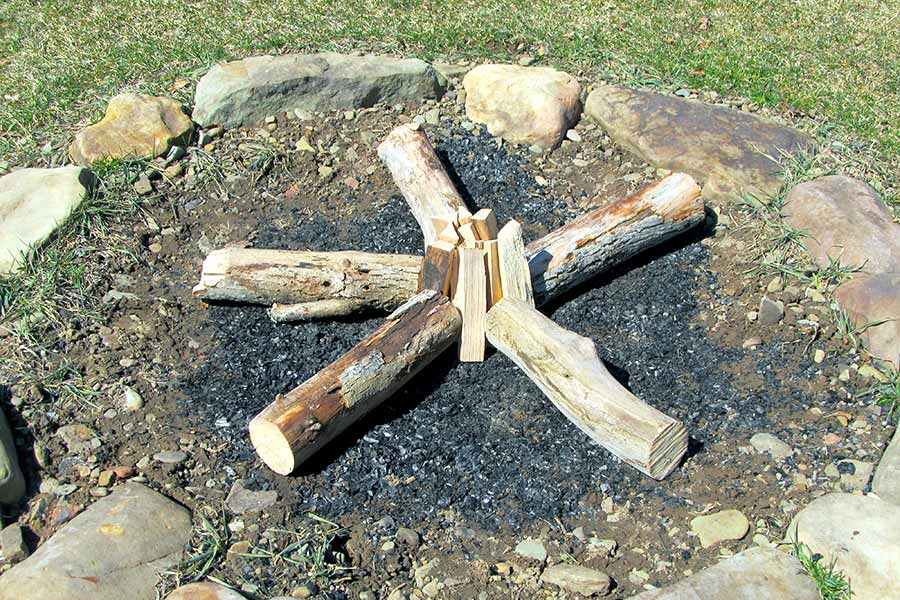
This is an effective way to start a campfire by arranging logs in a star-shaped configuration with an opening in the center for the tinder and kindling.
- In the fire pit, arrange five or six large logs to form a star shape, with the ends pointing towards the center, like spokes on a wheel.
- Leave an opening at the center for a pile of tinder and kindling.
- Ignite the tinder, as the wood burns, slide the logs toward the center into the flames to fuel the fire.

Other Posts of Interest
- How Do I Choose the Right Size Camping Fridge?
- What Vans Can You Stand Up In?
- The 10 Best Minivans For Camping
- How Long Does A Camping Fridge Last?
3. Lighting The Campfire
Lighters and Matches are convenient items for starting a fire, especially waterproof matches designed for outdoor use. Waterproof matches are resistant to moisture and other elements. They’re invaluable when having a reliable fire starter is critical.
Ferro Rods are another good option; they use hot sparks to ignite tinder. Ferro rods are waterproof, durable, and long-lasting, making them a popular choice for camping.
Flint and Steel is a fire-starting method used since ancient times. It consists of a piece of flint and a striker. Sparks are created when the striker is struck against the flint, which ignites the tinder.
Building a campfire will be easier when using the right tools and materials.
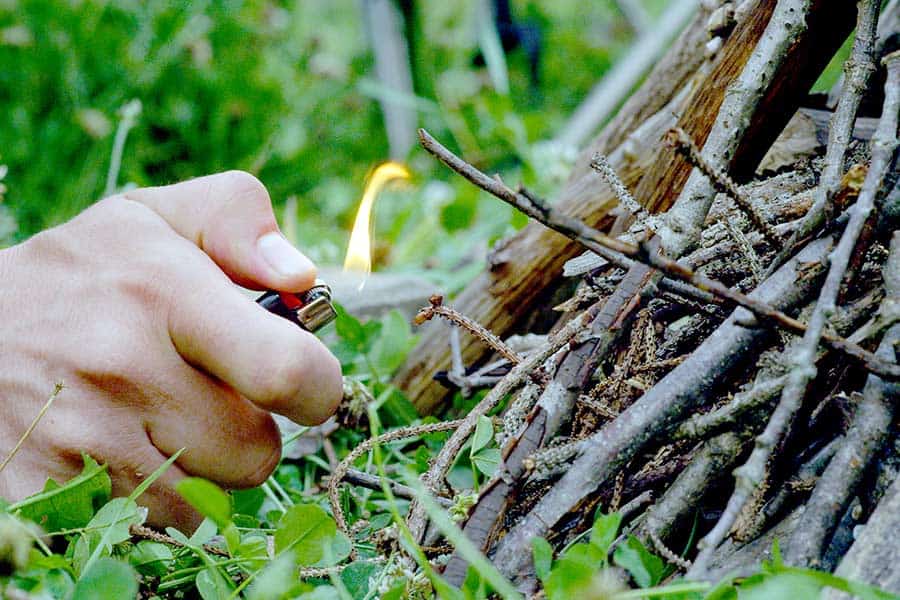
4. Being Safety Conscious
Sitting around a campfire is a great way to spend quality time with family and friends, but keeping safety in mind when enjoying one is essential. Here are some important tips for staying safe around the campfire.
- Confirm your campfire is legal; check with local authorities if you are unsure of the rules and regulations regarding open fires.
- Clear the area around the firepit of any potential combustible materials, such as dry grass, leaves, and branches.
- Avoid using accelerants to light a campfire. Instead, use proper fire-building techniques.
- Always keep a bucket of water or a shovel nearby in case the fire needs to be extinguished quickly.
- Never leave a campfire unattended, and make sure it is fully extinguished before you leave it.
5. Extinguishing the Fire
Extinguishing a campfire is just as important as starting one, so taking the necessary steps to ensure the fire is properly extinguished before leaving the area is important. Here are some tips for extinguishing your campfire:
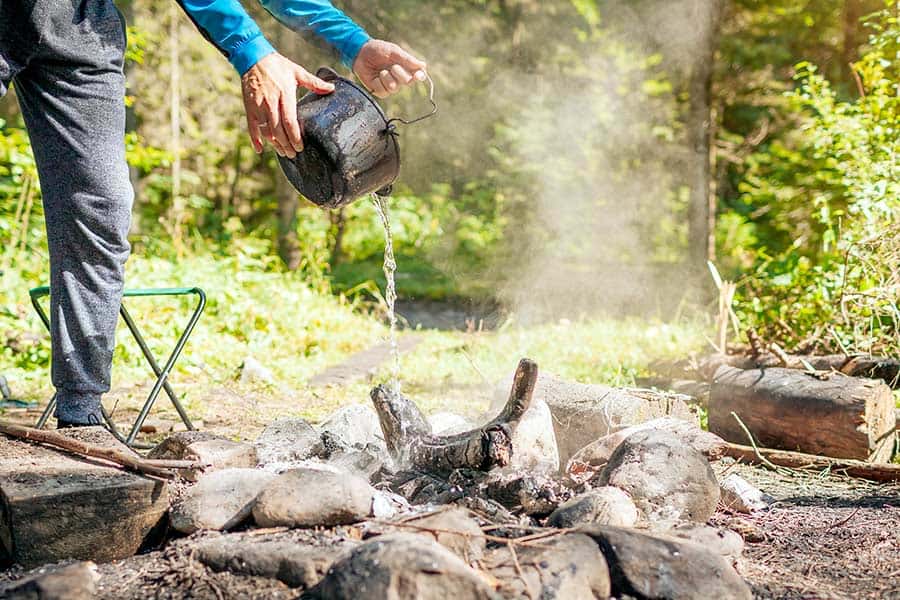
- Allow the fire to burn down entirely until no flames are visible. Then, pour water over the entire fire area until all the fuel and ashes are completely drenched.
- Stir the ashes with a stick or shovel after pouring water onto them, and add more water if necessary. Be sure to wait several minutes and check for any hot spots that may still be present to be sure that all embers have been extinguished.
6. Tips for Success
Gathering around a campfire, watching the flames dance, and hearing the crackle of the wood can be a mesmerizing experience. With the right know-how and preparation, you can build a campfire quickly and safely, creating unforgettable moments you’ll treasure.
When building your campfire, keep these tips in mind:
- Remember that fires should only be built in fire rings or fire pits.
- To easily start a campfire, take the time to build a proper structure.
- Use only dry materials—wet or damp materials will not burn efficiently.
- Make sure there are gaps between the wood pieces so air can flow freely through the structure.
- Once the campfire is burning steadily, use bigger logs to extend the burn time.
- Use a long stick to reposition the wood around the fire.
Up in Flames
Starting a campfire may seem like a daunting task, but with the proper preparation and knowledge, it can be easy and enjoyable. Finding the right materials to fuel your fire, building an effective structure, and practicing fire safety are all essential to ensuring a successful campfire.
With these tips in mind, you will have an enjoyable campfire experience. So gather your family and friends for roasted marshmallows under the stars – it’s time to light up the campfire.





